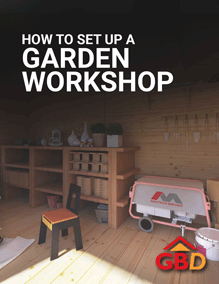A garden workshop can be a desirable part of any home, providing both practical and homely space from which to work, either professionally or for your hobby, arts, crafts or DIY projects.
It also provides a practical way to maximise the use of your garage, large sheds or other space that you may have within your garden area. Certainly, they can offer a better option than simply letting them get cluttered up with items you’ve stored and ultimately forgotten about.
Of course, if you’re going to create a workshop for regular use, then there are a number of things that you need to take into account a number of factors that will allow you to ensure that the space is set up exactly as you need it, providing you with the perfect environment for creative, productive and enjoyable work.
Make Practical Use of the Space
If you’re setting up a garden workshop at home, then you need to ensure that it’s set up to allow you to work.
This means that you need to consider the best way in which to maximise the space that you have.
Plan out your workspace, so that there is a practical logic the set up.
You need to ensure that you have enough room to work, so maximise floor space by removing any items that aren’t required, the less clutter you have, the better your working environment.
Once you’ve got a firm understanding of the room you have to work with, then you need to consider the layout. This is important for efficient and more rewarding work; as nothing frustrates or eats into time more than constantly searching or reaching for equipment.
EquipmentLayout
Speaking of equipment, you need to think about what equipment you will need and how it will best be laid out for optimal access and usage.
Will you be using machinery that requires floorspace? If the answer is yes, then consider equipment with mobile bases, so that they can be moved easier when required.
Also, give some thought to the order in which each piece of equipment is to be used. Are you able to create a practical workflow so that you move seamlessly from one item, machine or area to the next, allowing for an efficient, production line style of working?
Ensure You Have Sufficient Storage Space
Adequate and well-ordered storage can play a huge part in creating a garden workshop that’s practical, fit for purpose and enjoyable to spend time within.
Again, maximising the use of available space can make all the difference.
While it might be tempting to cover the walls with large works of art and photos, they really are better utilised as effective areas for storing your tools and other accessories. Installing shelving units and cupboards, and ensuring that every item has its own place gives your workshop a sense of order and keeps essential workspace clear.
Enabling you to work in a clear, unobtrusive way, while your equipment is neatly stored and well-maintained.
The likelihood is that you also have space underneath your worktops that can be useful for storing both equipment and smaller sundry items.
Consider installing drawers that fit beneath the work surface, into which smaller accessories, maybe screws, nails and similar items, can be kept. Or maybe some of the smaller hand tools that are required but less frequently used.
Keep Your Storage Logical and Accessible
Of course, while having things neatly stored is important, of equal importance is your ability to actually access the tools and items you need, at the moment you need them.
Just as the layout of your garden workshop can help create a productive workflow, so the way in which you store and order your items, and the ease with which you can reach them, can help make your work a lot easier and considerably less fraught.
Think about the tools that are required for each stage of the job, and store them in a handy location within the vicinity that the task will be carried out. For instance, if you are using a lathe, then ensure that your turning tools are within easy reach.
Your garden workshop should be no different to any other working environment when it comes to the use and storage of items.
Safe, tidy and out of the way when not needed, and readily available to be used when the task requires, without fuss, bother, or undue time-wastage.
Try to Keep Some Spare Room
Garage workshops can, if you let your guard down, quickly become overloaded and cluttered. With every new job completed, there’s usually some leftover items, screws, nails, cut-offs and such like that your instinct tells you can come in handy on future work.
While common sense will tell you that you need to be diligent to avoid too much clutter, it might be worth giving consideration to the fact that this will occur when you are setting up the workshop.
Can you retain some space to accommodate any items that you might accrue as time goes along? Maybe a small area for excess items that you can be more easily managed and audited, rather than just letting things pile up.
Also, if you are able to set up without using every last inch for storage, can improve the ambience of the workshop. After all you want the time you spend in there to be enjoyable as well as productive, so if you can avoid it getting too cramped and claustrophobic that will certainly help.
Have You Got The Power?
The one thing that you are going to need in your workshop, that you need to be aware of from the outset, is electricity.
Whether operating machines, having lighting for night time work, or even just listening the radio or making a cup of tea, ensuring you’ve got adequate power for the time you spend in the workshop is essential.
Now, it might be that you are converting your garage that already has an electricity source. It’s still worth ensuring that it’s fit for purpose if you increasing the output.
On the other hand, if your space doesn’t have any electricity going to it, then you’ll need to address this early in the process. Consider what you need, where the power sockets need to be located, and the kind of lighting you require.
And then appoint a qualified electrician to ensure that it’s all installed and set up correctly and safely.
Summary
Whether for home-operated businesses, arts and crafts, woodworking or just simple DIY and repairs, a garden workshop can be a great and extremely useful addition to your home, and utilised for a wide range of reasons.
But, just the same as a professional place of work, you really should play careful consideration to the set up from the outset.
Think about the layout, the storage and the kind of work you’ll be carrying out, as well as the more practical things such as electrics and the equipment you’ll need. Getting all this correct from the outset can ensure that you will have a garden workshop that’s useful, pleasant to spend time within, and a valuable asset to your home for years to come.


